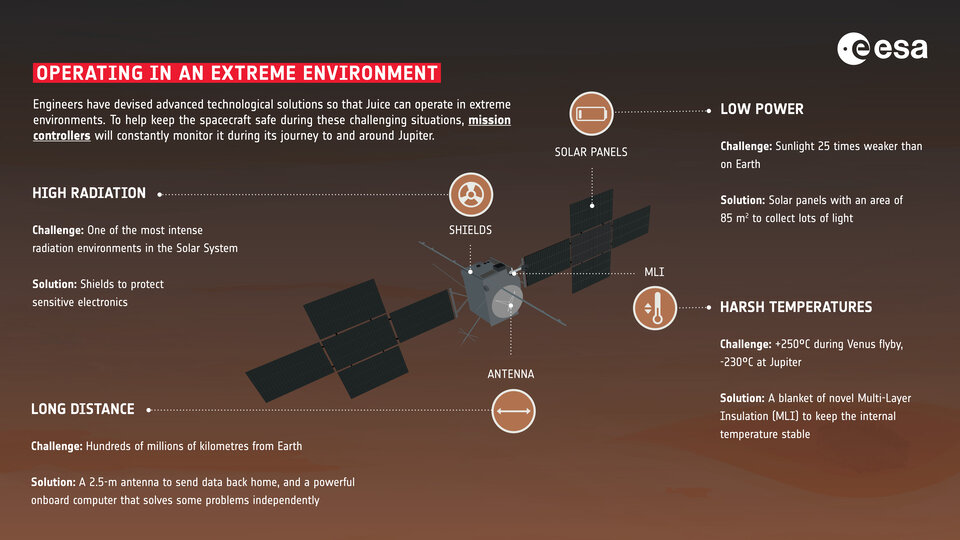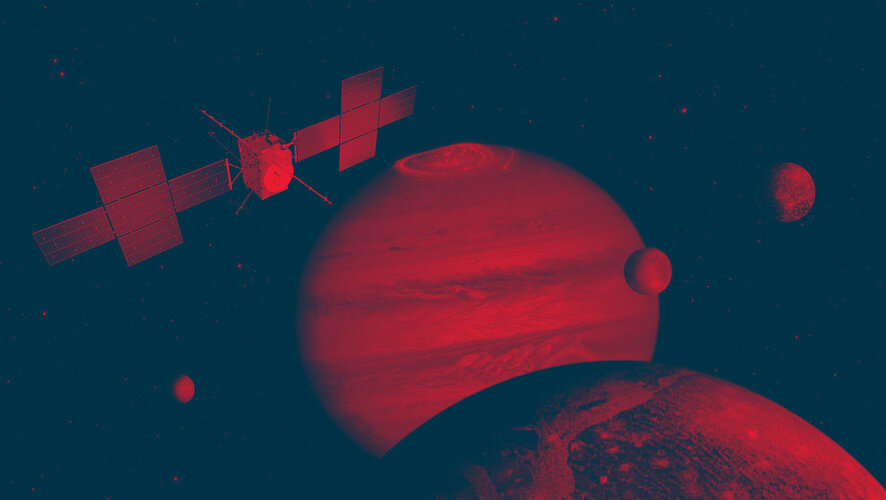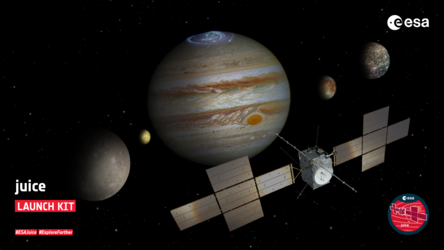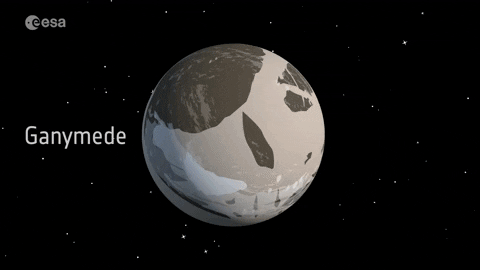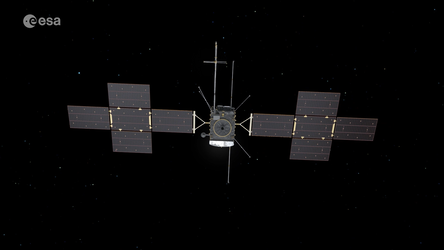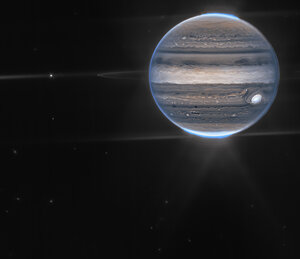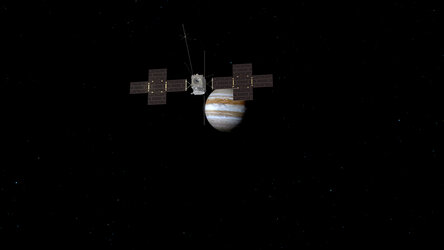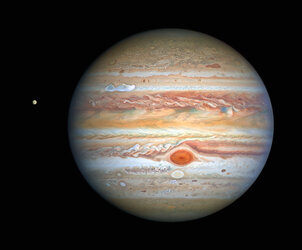Juice spacecraft specs
ESA’s Jupiter Icy Moons Explorer (Juice) is currently heading to Jupiter to explore the planet, its wider space environment, and its moons.
Juice’s instruments have been carefully selected to achieve a number of core science goals, and the spacecraft itself has been expertly designed to operate under some of the most extreme conditions found in the Solar System.
About the spacecraft
Juice will first orbit Jupiter and then move across to orbit the large moon Ganymede, after completing a number of flybys of other planets in the Solar System on its eight-year-long journey to Jupiter. The spacecraft is roughly cuboidal, with two large cross-shaped ‘wings’ of solar panels on either side, several extending booms and antennas, and a large dish-shaped antenna on one face (Juice’s High Gain Antenna).
Dimensions (stowed for launch): 4.09 x 2.86 x 4.35 m
Dimensions (deployed in orbit): 16.8 x 27.1 x 13.7 m
Dry mass (without fuel): 2420 kg. This includes the 'payload adapter' that connects the satellite to the launcher.
Amount of propellant (full tank): 3650 kg. This is a reasonably large volume compared to the spacecraft’s dry mass due to Juice’s numerous planned flybys, manoeuvres and change of orbit from Jupiter to Ganymede (and subsequent necessary orbital reductions at Ganymede).
Instrument payload mass: 280 kg
Antennas and booms: Juice's antennas and booms will hold numerous magnetically sensitive sensors away from the spacecraft's body, to avoid any interference and disturbance as the instruments study the intricacies of Jupiter's magnetism. Juice will carry a 10.6-metre-long deployable boom for its Juice Magnetometer (J-MAG) and Radio and Plasma Wave Investigation (RPWI) instruments, and a 16-metre-long deployable antenna for its radar instrument (RIME). RPWI has three additional electric 2.5-metre antennas (known as RWI) and a three-axis Search Coil Magnetometer (SCM), both of which are mounted on the J-MAG boom, and four 3-metre deployable booms. The 3-metre booms each carry a Langmuir probe of 10 cm in diameter, and are mounted on the body of the spacecraft itself in a tetrahedral configuration (these are known as Langmuir Probe – Plasma Wave Instruments, or LP-PWI). The other instruments will all be mounted on the spacecraft body apart from the radio science experiment (3GM), which is contained within.
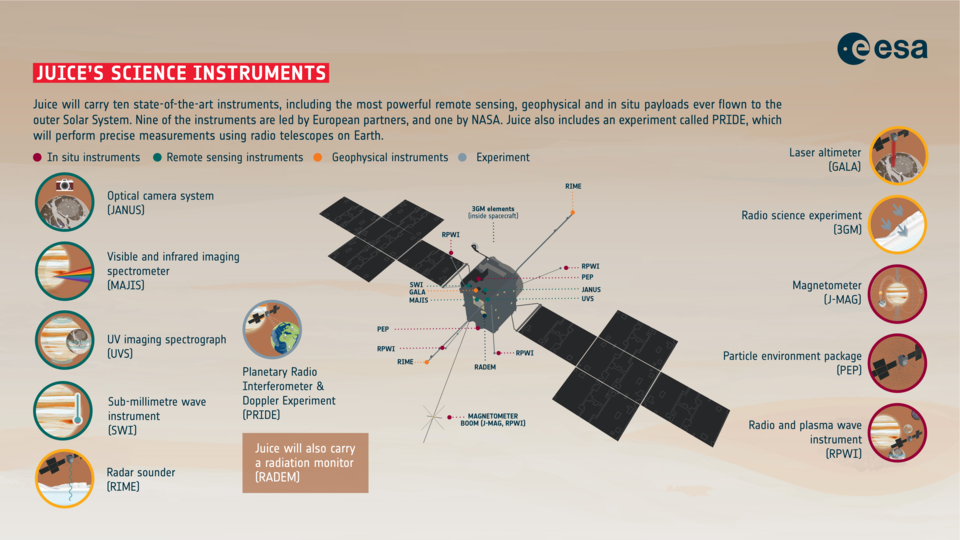
Solar panels: Juice has a distinctively shaped solar array – two ‘wings’ of panels in a cross-like formation. Overall, these wings are made up of ten 2.5 x 3.5 m panels (five on each side) with a total area of 85 m2 (and a total of 23 560 solar cells) – the largest ever built for an interplanetary spacecraft, measuring 27 m from tip to tip. Their shape allows them to be large in size but also to fold up neatly inside the launcher (an Ariane 5 rocket) so they can leave Earth’s surface and successfully deploy in space.
Power: The large area of Juice’s solar ‘wings’ produces sufficient power for the spacecraft’s onboard systems and instruments – approximately 850 W – despite operating so far from the Sun. At Earth, such a surface area could power an entire road of houses, but at Jupiter, it can power a single microwave just once.
Communications and data transfer: Data will be returned to Earth, and telemetry/communications links created for routine and science operations, via the 2.5-metre High Gain Antenna (HGA, which resembles a satellite dish and is easily visible on the spacecraft’s body) and a steerable medium gain antenna. The latter will enable data to be returned to Earth during flybys of Venus, when the HGA will work as a sunshield to protect Juice’s instruments, and during some manoeuvres at Jupiter. Juice can achieve a downlink transfer rate of more than 2 Gb/day (to ESA ground stations with Deep Space Antennas).
Attitude control: Juice is a three-axis stabilised spacecraft, meaning that a number of spinning wheels (‘momentum wheels’) are used to adjust its orientation in three axes and in relation to other celestial bodies. Juice will also use a supporting propulsion system to keep the craft in its desired position and to adjust its attitude and orbital parameters at Jupiter and Ganymede. This will enable Juice to continue pointing ‘down’ to gather scientific observations during its flybys, and to effectively move the large solar panels as needed.

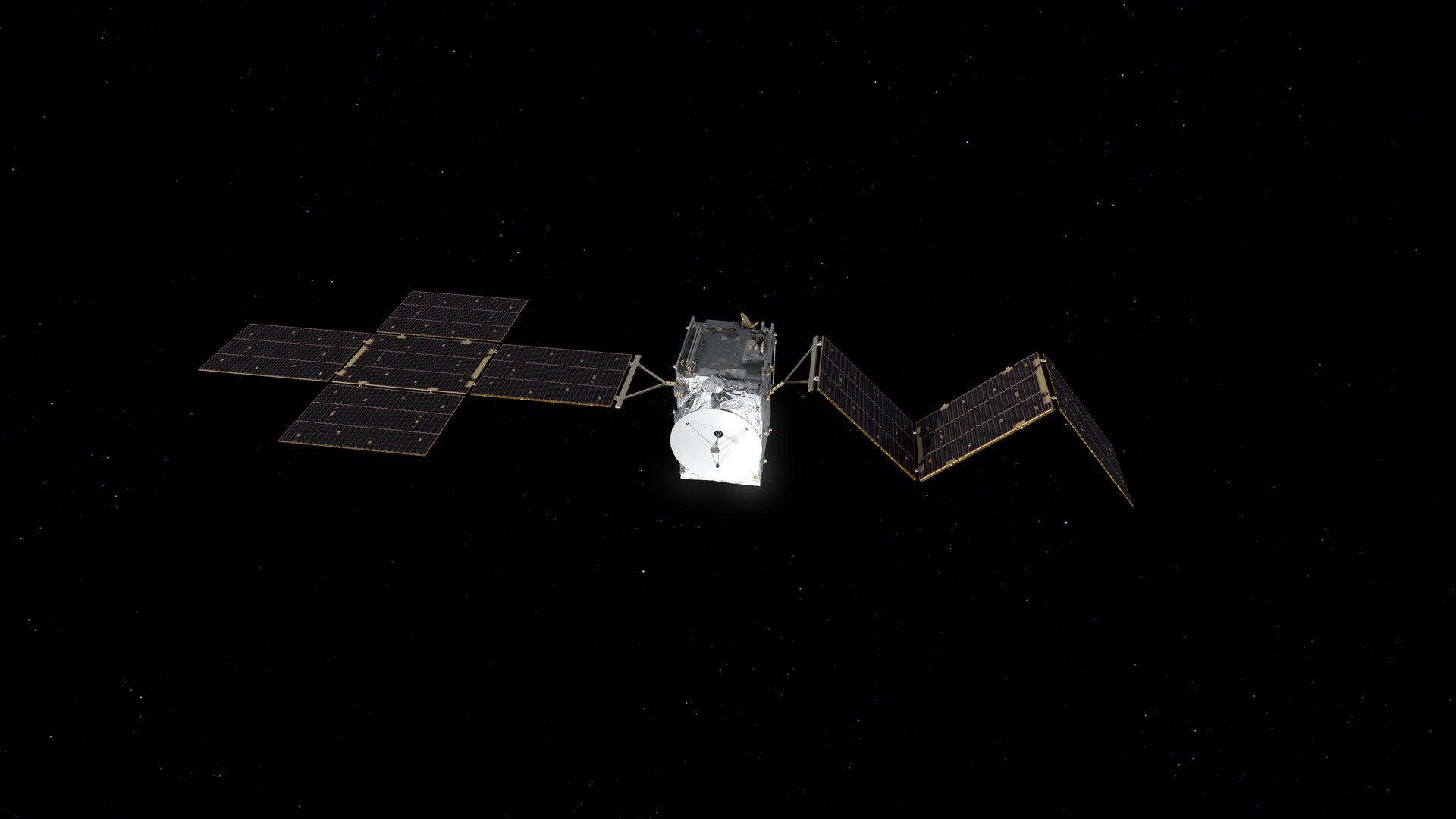
Access the video
Thrust: Juice has a main engine capable of producing 425 N of thrust (necessary for deep space manoeuvres, orbit insertions and gravity assists). It has a bi-propellant chemical propulsion system, using mono-methyl hydrazine (MMH) fuel and mixed oxides of nitrogen (MON) oxidiser. This results in a propellant that spontaneously ignites when the two come into contact with each other.
Batteries and data storage: Juice’s instruments will generate a lot of scientific data. The spacecraft will have a large mass memory able to transmit data to Earth, and to withstand the harsh radiation environment of Jupiter. Juice also carries five battery modules – like a large battery bank – so that operations can continue when the spacecraft passes behind the various bodies of the Jupiter system (eclipses that can last up to 4.8 hours) and no longer sees the Sun. Juice has sufficient storage (1.25 Tb) for several days of science data.
Autonomous operation: As Jupiter is over 600 million km away, communicating with the spacecraft would take over 1.5 h. Juice is therefore designed to operate fully independently, and to react and recover from any possible problems it may completely autonomously. This is hugely complex considering Juice’s journey, which involves gravity assists during its cruise phase, two orbit insertion manoeuvres and 35 icy moon flybys!
Electromagnetic cleanliness: As a key goal is to monitor the magnetic fields and charged particles at Jupiter, any electromagnetic fields generated by the spacecraft itself must not interfere with the sensitive scientific measurements. Juice’s solar array electrical architecture, power distribution unit, and attitude systems have all been carefully designed to ensure that this is the case.
Optimised for the outer Solar System
Juice has been designed to withstand a number of the core challenges facing spacecraft travelling to the outer Solar System, namely: high radiation, low power, long distances and harsh temperatures.
Levels of sunlight at Jupiter will be 25 times weaker than on Earth – a real issue for a spacecraft relying on solar power. To remedy this, Juice has large solar panels to capture as much light as it can. This distance also creates an extreme temperature environment; Juice will be wrapped in 500 protective thermal insulation blankets (so-called ‘Multi-Layer Insulation’ with an overall mass of 100 kg) to help regulate its temperature and keep its interior stable given the changeable conditions the spacecraft will experience throughout its lifetime (lows of -230°C and highs of 250°C at Jupiter and during its flyby of Venus, respectively).
The radiation environment at Jupiter also poses a challenge, as it is one of the most intense in the Solar System. Jupiter’s magnetic field is so strong that squeezes the interior of its closest moon, Io, keeping its volcanoes in continuous eruption and creating extremely high levels of radiation in this region. In response to this, Juice is equipped with shields and special protective vaults to protect its sensitive electronics and enable them to achieve their scientific objectives, and some electronics have also been made radiation resistant.
To help alleviate hurdles associated with the spacecraft operating so far away from us, Juice has a powerful onboard computer and navigation system able to perform operations autonomously and solve problems independently, without needing to contact Earth at all.
Read more about how Juice has been expertly equipped with technological solutions to enable it to operate at Jupiter: Operating in an extreme environment (infographic).
About the instruments
Juice will carry 10 state-of-the-art science instruments to Jupiter, plus a radiation monitor and an experiment carried out in collaboration with radio telescopes on Earth (PRIDE).
For more information on Juice’s advanced suite of instruments, explore our infographic and read the more detailed information on our science page.



